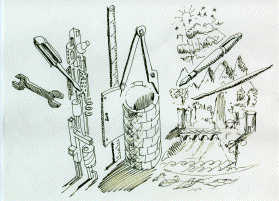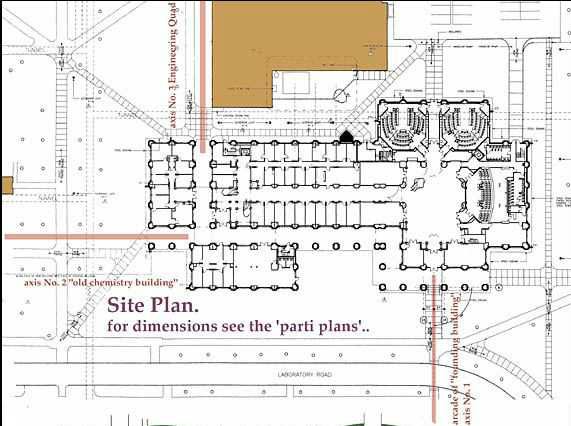 |
The General Plan |
the "unofficial" Duncan Hall web site
|
|
Rice University |
| Houston, Texas, USA |
|
Duncan Hall is a three story building that sits on
the corner of Rice's Engineering Quadrangle.
Because of its prominent location on campus, the
building must address both Lovett Hall and Physics,
to the south, and the remainder of engineering, to
its north and west.
The layout and plan of the building evolved to reflect
these relationships.

The Main Entry
The front door to Duncan Hall terminates one of the
critical vistas on campus-the arcade of Lovett Hall.
Duncan Hall was sited by lining up the central axis of
Martel Hall (from the main doors on the south to the
parking lot entrance on the north) with the lamps hanging
in the center of the Lovett Arcade.
Since, in some sense, Duncan terminates the arcade of
scholars along Lovett, Outram left room on the entry
facade for relief sculptures of four final scholars.
The thought, at the time, was that we would fill these
with four people who played a critical role in the
development of computation and its application to
engineering.
For a variety of reasons, including cost, the sculptures
were dropped from the project. The frames, however,
remain.
The Engineering Quad
Approaching Duncan from the Engineering Quad, you
enter an arcade at the corner by Abercrombie Laboratory.
The eastern wall of the arcade lines up with the exterior
wall of Abercrombie, leaving open the possibility of
connecting these two buildings with an exterior arcade.
How did Outram match the disjoint alignments of Abercrombie
and Lovett, given that the basic 18 foot 8 inch module
of Duncan was already fixed?
If you look closely at the joint between the southeastern
wing (housing the main entrance) and the body of the
building, you will notice a column that is almost doubled.
This so-called "double-bubble" contains the extra length
required to reconcile the Lovett Hall arcade, the
face of Abercrombie, and the building's internal grid.
Setback from Laboratory Row
Duncan Hall sits behind a majestic row of live oaks.
Some distance was required to ensure that the trees
had healthy root systems. The question was, how much.
To determine the setback from the street, the board
aligned the centerline of Duncan's arcade with the
centerline of the arcade on the George R. Brown
Laboratory. That is, if you knocked down the old
Chemistry Building (now the Keck Laboratory), the two
arcades would be aligned.
Interior Plans
To accomodate all of the offices, laboratories, and
classrooms on this constrained site, Duncan Hall has
a set of narrow serpentine halls lined with
offices. The floor plans show the general layout of
the building.
- The first floor shows the
classrooms, auditoriums, and two conference rooms
around Martel Hall, the long street
lined with offices, and the outposts for the Dean's
suite and the Symond's teaching center. (It occupies
the wing labelled "E.C. Laboratory.)
- The second floor houses
offices, laboratories, the top of the auditorium,
and some common spaces. The
cliff-hugging hallway along the street is one of its
best features.
- The third floor has
even more offices and laboratories. The top of Martel Hall,
is ringed with public spaces-two conference rooms and
the bridge. The three labs to the east of Martel Hall
were actually built as a single open room.
It seats roughly fifty for meetings or meals.
These plans do not show room numbers.
Rooms are number consecutively, starting at the elevator in the
West Hall and running counter-clockwise around the building.
Since all three floors have a different number of offices,
the numbers do not line up vertically.
(For example, rooms at the main entrance are numbered 1046 on
the first floor, 2063 on the second floor, and 3076 on the third
floor.)


